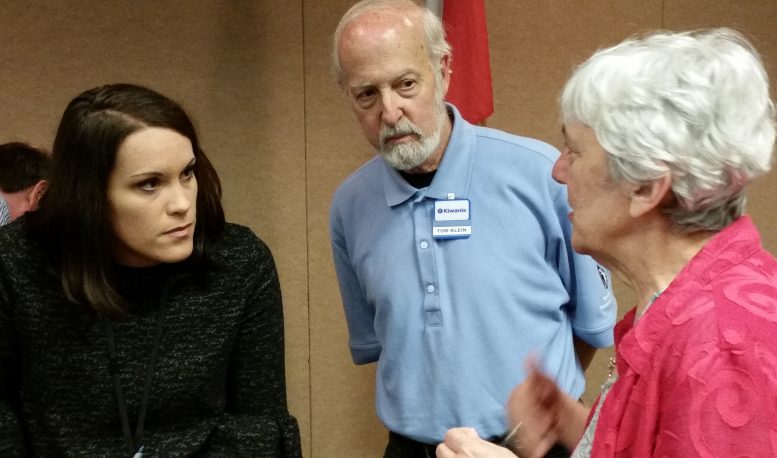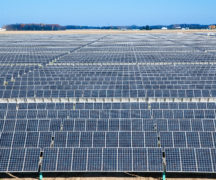By JAN LARSON McLAUGHLIN
BG Independent News
Before creating a community Climate Action Plan, Bowling Green officials decided they first needed to identify greenhouse gas emissions from the city itself.
The inventory of city emissions found that the biggest sources of greenhouse gasses are the community’s water and wastewater treatment facilities.
“They are huge users of electricity and natural gas,” Amanda Gamby, sustainability and public outreach coordinator for Bowling Green, reported last week to a City Council committee.
The city “takes the hit for all the emissions” since it owns and operates the facilities, even though it treats water and wastewater for surrounding communities, Gamby said. “We’re responsible for the emissions.”
The second largest greenhouse gasses from city facilities came from the municipal court, the police division, and the city administration building.
Releasing smaller emissions were the city’s vehicle fleet, solid waste facilities, employee commutes, street lights and traffic signals, and transit fleet.
According to Gamby, it’s unusual for a smaller city like Bowling Green to conduct a greenhouse gas emissions inventory.
“I’m not sure how many communities of our size are touching this,” she said.
City Council committed to the development of a climate action plan for Bowling Green at a February 2020 strategic planning meeting.
Council set the goal of net zero greenhouse emissions for city operations by 2040.
The first step in creating the Sustainability & Climate Action Plan was measuring the city’s greenhouse gas emissions. Primary greenhouse gasses include carbon dioxide, methane, and nitrous oxide. Understanding the city’s current greenhouse gas emissions will allow the community to set goals and measure progress, officials said.
The city’s sustainability inventory focused on:
- Energy use
- Waste management
- Green space
- Transportation
- Water use
- Education and outreach
With the completion of the Greenhouse Gas Emissions Inventory, the city is now working to put together a committee of internal and external stakeholders to begin developing a Climate Action Plan. Gamby said the final composition of the committee will likely be announced later this month.
Bowling Green City Council member Jeff Dennis asked last week about the city’s goal to offer recycling in the downtown area.
Gamby said that will come later.
“We’re trying to get our own house in order before we tackle others,” she said. “It’s on the list.”
The resolution adopted by council states that “bold action is required to avoid the worst impacts of climate change, and efforts to control climate change have many benefits such as cleaner air and water, improved health, local employment, cost savings for households, businesses, and the city, and the creation of a stronger and more resilient community.”
Last year, Mayor Mike Aspacher asked that the following steps be undertaken by the city:
• Working with the Downtown Bowling Green SID and business owners to develop a pilot recycling program for downtown businesses.
• Completing a litter study and evaluating the need for additional trash receptacles in public areas.
• Continuing to be leaders in the climate action movement by completing an emissions inventory.
• Involving and engaging the community in educational outreach programs and incentives.
• Continuing to promote the sustainability efforts already underway in Bowling Green.
• Continuing to add electric and hybrid vehicles to the city’s fleet.
• Reviewing the impacts and possibility of adding additional electrical vehicle charging stations in public areas as well as the possibility of adding electric charging stations in private parking lots.
A report from Aspacher in 2021 referenced key findings of a sustainability study that demonstrated proactive operations and policies already in place:
• 40% of BG energy is from renewable energy sources, greatly exceeding the state average of 3% and national average of 20%.
• Bowling Green is home to the first commercial wind farm in Ohio and, currently, the largest solar field in the state of Ohio.
• To help reduce electric consumption and increase efficiency, the city has provided the Efficiency Smart program to its residents and businesses for over 10 years, resulting in an annual CO2 savings of nearly 70,000,000 pounds.
• Residents are provided the EcoSmart Choice program allowing customers the option to pay a little more for their electrical usage to support renewable energy – up to 100%.
• Bowling Green has 400 acres of park land covering 10 sites – a park within roughly 1.5 miles from every home.
• The City of Bowling Green supports recycling/organics recycling programs including the recent expansion of the curbside recycling program and the addition of the Pilot Food Waste Drop Off.
• The City of Bowling Green Municipal Utilities department has built and maintains state of the art water and wastewater treatment facilities that meet or exceed federal water quality requirements, as well as EPA wastewater standards, and continues to make improvements to increase water quality, reliability, and sustainability.
• BG has invested in sustainable building practices with new city facilities such as the planned City Building and recently completed City Park Veterans Building, as well as renovation projects to city owned buildings.


